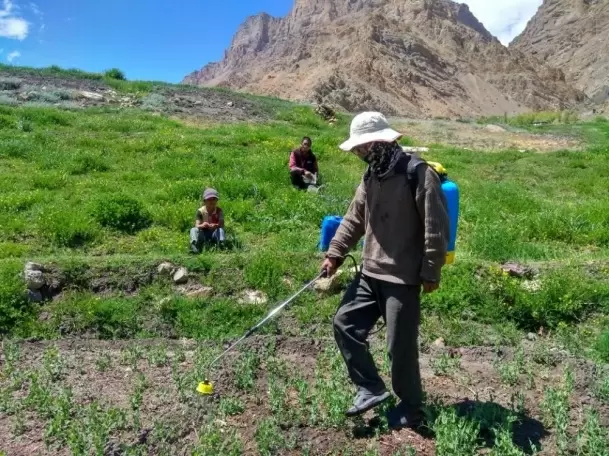A ray of prosperity at end of 9.2-km long Atal Tunnel
29-September-2020

There is going to be prosperity at the end of 9.2-km long horseshoe-shaped single-tube, two-lane Atal Tunnel -- one of India's strategically most important infrastructure projects beneath the majestic Rohtang Pass -- in the Lahaul Valley of Himachal Pradesh where 20,000 people remain cut off from the rest of the country every winter.
As it brings the landlocked valley close to the rest of the world even during the forlorn winter months when the area is covered under forgetful snow, its people are looking forward to continuous supplies, trade and tourism with the opening of the tunnel, earlier named after Rohtang Pass.
The strategic Atal Tunnel, constructed by the Border Roads Organisation (BRO), a wing of the Defence Ministry, in collaboration with Afcons, a joint venture with Strabag AG, under the 3,978 metre Rohtang Pass in the Pir Panjal range, is all set to be inaugurated by Prime Minister Narendra Modi on October 3.
The tunnel's north portal lies towards Lahaul and Spiti district, while the south one is towards Dhundi, some 30 km from Manali.
"We were desperately awaiting the completion of the tunnel that was initially proposed to be completed by 2015," octogenarian farmer Bidhi Chand of Keylong town told IANS over phone.
"This will end our miseries forever," he said.
"We are happy that at least in our lifetime, we will be able to see the tunnel that is going to ensure the all-weather connectivity with the rest of the state for the people of Lahaul," said Heera Singh of Sissu village.
Sissu is the venue where Modi will get a warm welcome by locals donning traditional dresses. He will be reaching there to address a small gathering after inaugurating the tunnel at its south portal.
After crossing the 9.2 km-long tunnel in less than 10 minutes towards its south portal, Modi will proceed toward Sissu.
He will attend his second and last small public meeting at the Solang Valley, towards the tunnel's south portal.
In the morning, Modi will be landing at the Snow and Avalanche Study Establishment (SASE) helipad base near Manali at 9.30 a.m.
The Rs 1,495-crore tunnel's foundation stone was laid by United Progressive Alliance (UPA) chairperson Sonia Gandhi on June 28, 2010, in the picturesque Solang Valley near Manali.
The tunnel -- a dream of former Prime Minister Atal Bihari Vajpayee and named after him posthumously -- missed its February 2015 deadline.
As per the BRO, despite delays the tunnel is going to finish within Rs 3,200 crore out of the sanctioned Rs 4,083 crore.
Chief Minister Jai Ram Thakur, who is leaving no stone unturned to make Modi's visit historic but low-key given Covid times, told IANS the tunnel would also be a boon for the cold deserts of Lahaul Valley, where over 20,000 people remain cut off in winter with the snapping of road links via the Rohtang Pass.
The celebrations have been scaled down to ensure strict physical distancing norms, he said.
Besides reducing road distance by approximately 46 km and saving travel time between Manali and Keylong towns, the tunnel has the capacity to ply 3,000 vehicles per day under any weather condition.
Hotelier Nakul Bodh said the construction of the tunnel would ensure round-the-year flow of tourists to the Lahaul Valley, which will boost the local prosperity.
"After Manali, Keylong and its nearby areas will be the preferred tourist destinations. Even tourists staying in Manali can make a round-trip to Lahaul," he added.
The tunnel is located at picturesque but breathtaking altitudes ranging above 3,000 metres in the western Himalayas. It lies beneath the snow covered Rohtang Pass, 70 per cent of which remains under snow even during summer.
For locals, the tunnel is a boon.
"No vegetable other than peas and potatoes that grow locally reach here once the road link via Rohtang Pass snaps in December. For at least four months, we have to relish only the stored vegetables, meat and fruits. Now we will get the fresh supply via Atal Tunnel," housewife Reshma Bodh said.
Till last winter, heavy snowfall high up the Rohtang Pass would close the road connectivity to Lahaul-Spiti district, the lone state-run helicopter, which normally operated once in a week to transported the locals, as it was the only mode of transportation.
The Lahaulis, as the locals are called, are mostly farmers and grow mainly peas and potatoes.
The Buddhist-dominated district in the Himalayan terrain attracted globetrotters mostly during summer until now. - IANS
Conspiracy Underway To Remove Nitish Kumar, Claims Mukesh Sahani
‘Something Wrong’: SC Questions Madras HC’s Handling of Karur Stampede Case
Sir In Bengal: Eci Identifies 58 Lakh Excludable Voters After Enumeration Phase Ends
Shivakumar Defends Hate Speech Bill, Accuses BJP Of Spreading Division, Hatred Among People
Opposition Moves to Impeach Justice G R Swaminathan; Kanimozhi Cites Loss of Public Trust









